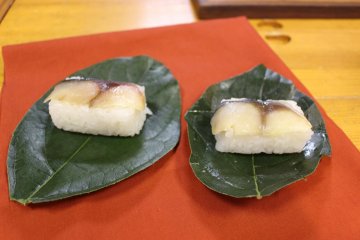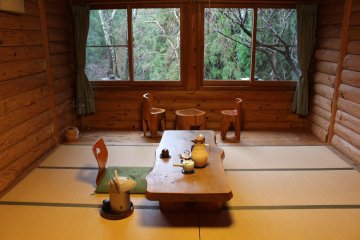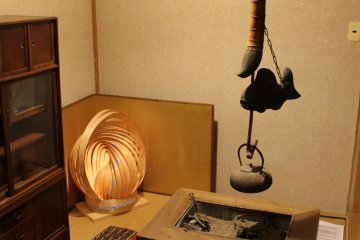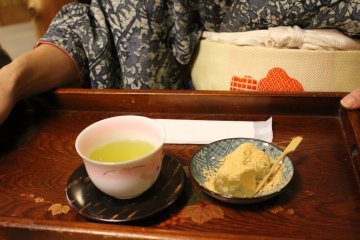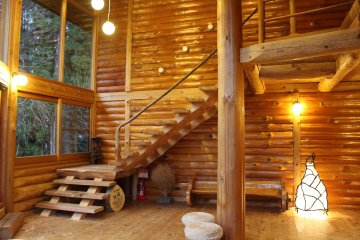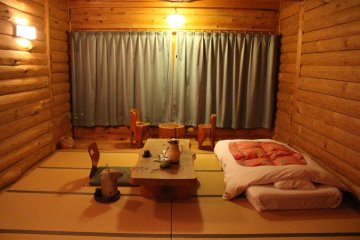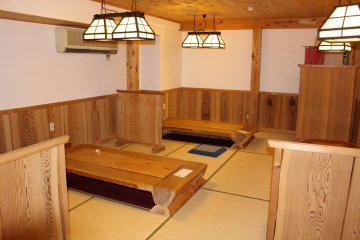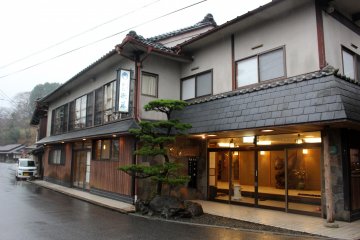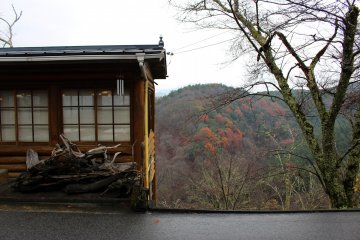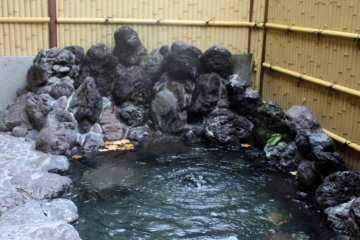My inner 8-year old exploded into excitement as I took in the interior of the Ryokan Kato. It was all I could do not to leave the receptionist in my dust and go running away down the hallway giggling. I broke out my camera and started firing away letting loose a few, "Oh my god!"s when a piece of art or architecture tickled my fancy.
Ryokan Kato
Traditional architecture and a long history can make a ryokan, or Japanese Inn, rustic and beautiful, but to be great it has to do something more: it has meet or exceed what one expected or imagined staying in Japan would be like when they first saw a travel brochure for Japan overseas. The Ryokan Kato on Nara's famous Yoshinoyama cherry blossom mountain achieves that fabulously. From writing guests names and bidding them welcome on a board outside the entrance, to the warm all wood construction and the simple, beautiful and elegant design Japan is known for, a few historical pieces of art and furniture from days gone by (or modern replicas that recall them), and the stunningly beautiful environment of Mt. Yoshino, Ryokan Kato combines all these things to create an experience far beyond the promise of any brochure. The view out the lobby sitting area's French doors, an explosion of autumnal fire on the mountain opposite the ryokan framed by a log house cafe, the skeleton of a sakura tree (devoid of both flowers and leaves in the late fall), and the narrow road outside the ryokan ending at a slope descending into a sakura forest, made carrying on a conversation with my group a challenge.
Ryokan Kato is divided into three parts, the Hon-kan (or main/original building), the log house at the back of the ryokan, and the Hinata Bokko Log House Cafe across the street. The original Honkan was built during the Edo-period more than 200 years ago. It was completely refurbished and rebuilt in 1989 using locally sourced cedar and cypress trees and the Log House rear section and Hinata Bokko Log Cafe were added and completed 5 years later. The Honkan and Log House are where guests stay and the Hinata Bokko Log Café is where breakfast is served and visitors to Yoshinoyama can come for coffee or tea. My room was in the log house. It was spacious, clean, had the rustic countryside atmosphere of the log house construction, the Japanese atmosphere of thrush tatami mats and low tables, and a view of the sakura trees and pine tree forest behind the Ryokan Kato. The provided futon was plush, supportive and comfortable. I had one of the best night sleeps I've had while traveling in Japan. The trend of exceeding expectations continues in Ryokan Kato’s hot spring baths. The indoor baths are constructed from beautiful Yoshino cedar trees and the outdoor baths from blue Yoshino River stones (they turn a blue green color when wet) and are surrounded by faux bamboo fences. Thin pieces of cedar wood cut in the shape of sakura flowers, sakura petals and maple leaves decorate the surfaces of both indoor and outdoor baths (rather like a romantic husband or boyfriend wooing his lady with rose petals in a bath). It was a charming and fun touch I've not seen at any other hot spring or ryokan.
Dining
Besides the great atmosphere and the comfortable accommodations, Ryokan Kato offers delicious countryside Japanese "kaiseki" course dining. The main dish of my dinner, Yamato chicken nabe (locally farmed chicken and vegetables and kuzu kiri cooked in a hot pot over an open flame in front of diners) had a simple but think soy and chicken stock broth that was savory enough to have me liking the bowl, manners be dammed. Goma tofu (sesame tofu), small fried wakasagi fish topped with congealed vinegar and red pepper (the sauce gives the fish an enjoyably sweet, sour and mildly hot flavor), tsukemono (Japanese vegetable pickles that had been salted and fermented to an appealing sour salty flavor), long green onions in spicy miso (sweet tangy with just a hint of heat), mashed purple sweet potatoes stuffed with sweet white bean paste (sweet enough to be a dessert), mushroom kimchi salad in a lemon skin, long-armed shrimp (the whole thing can be eaten shell and all, it's salty like a saltine cracker, less crunchy but oddly satisfying to bite into), chestnuts in kuzu koro (kuzu starch pastry) skin, deer sashimi (pleasantly chewy and delicious topped with ginger and dipped in soy sauce), salted and roasted ayu fish, and vegetable tempura with sakura salt made for a satisfying and filling meal. Ryokan Kato’s menu changes with the season and guests can request specialties like wild boar if they so choose.
Around Ryokan Kato
Ryokan Kato sits on the lower slopes of the World Heritage Mt. Yoshino meaning sites like Kinpusenji Temple, the 2nd largest wooden structure in Japan and headquarters of Japanese Shugendo Buddism, and Yoshimizu Shrine, the palace of exiled Emperor Go-Daigo from 1334-1392, are within walking distance. It's also surrounded by Yoshino's 30,000 or so sakura trees and their glorious pink flowers in the spring season and the fiery autumn colors of the local deciduous trees in the fall. Relatively cool summer temperatures and the beautiful winter scenery of Mt. Yoshino make it a great place to visit any time of year.
Getting There
Ryokan Kato and Mt. Yoshino are off the beaten path but easily accessible by train. Kintetsu local, express and limited express service trains run directly there from Osaka Abenobashi Station (¥970 and 92 minutes on the regular express and ¥1,480 and 76 minutes on the limited express). Ryokan Kato has a free shuttle service from Yoshino Station. Alternatively, one can ride the aerial tram from Yoshino Station to the top of Mt. Yoshino and make the 5 or so minute walk to Ryokan Kato from the summit station.



